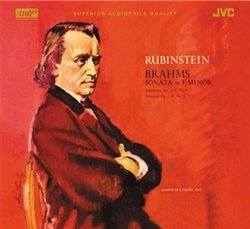| All Artists: Johannes Brahms, Artur Rubinstein Title: Brahms: Sonata No. 3 in F minor, Op. 5 Members Wishing: 1 Total Copies: 0 Label: Jmc / Xrcd Original Release Date: 1/1/2000 Re-Release Date: 1/20/2004 Genre: Classical Styles: Forms & Genres, Sonatas, Historical Periods, Modern, 20th, & 21st Century, Romantic (c.1820-1910), Symphonies Number of Discs: 1 SwapaCD Credits: 1 UPCs: 693692401028, 4975769286261 |
Search - Johannes Brahms, Artur Rubinstein :: Brahms: Sonata No. 3 in F minor, Op. 5
 | Johannes Brahms, Artur Rubinstein Brahms: Sonata No. 3 in F minor, Op. 5 Genre: Classical
|
Larger Image |
CD Details |
CD ReviewsA wonderful Brahms 3rd piano sonata with Arthur Rubinstein knick-knack | 03/23/2005 (5 out of 5 stars) "This is the XRCD release of Arthur Rubinstein's 1959 recording of the Brahms 3rd sonata in F minor and two short pieces: Intermezzo no 6 in E Opus 116 and Romance no 5 in F Opus 118.
If you're not familiar with the Brahms 3rd sonata, it's a wonderful piece, especially when played like this. The two short pieces are little beauties as well. Arthur Rubinstein is one of the greatest pianists in history. He was born on January 26th 1886 (or 1887 depending which version you believe) in Lodz, Poland, and lived well into the latter half of the 20th century, making many recordings along the way. He was in his mid seventies when he made this particular recording and the performance we hear is of wonderfully developed, mature, sensitive and at times whistful playing. This guy had an entire life behind him when he sat down in the studio to record this piece. Rubinstein's technical playing is rock solid. His chords, octaves and passage work simply ring out. Then there's his incredible pulse and timing. Rubinstein moves the music around, always keeping forward momentum, but especially giving time and space in order to lead into the next phrase or simply to bring out a melodic line. The musical lines that Rubinstein makes can - like in the second mvt. - span an entire mvt. You're never dropped or let go from the world into which you've been drawn. He moves you along with the flow and then sometimes leaves you hanging on a note in order to lead you perfectly into the next phrase or section. There aren't many musicians who can keep a musical line going for ten minutes (Artur Schnabel and Glenn Gould also come to mind of course). Complementing this is Rubinstein's wonderful sense of harmony, which plays an integral part in making total sense of the piece; whether it's bringing out a harmonic change, introducing a modulation that initiates a new section or change of direction, a captivating story is being told here. And then of course there's his sound. Amazing. A rich, "singing" sound with great depth and power. His crescendo into the climax at the end of the second mvt. is monumental. Rubinstein certainly knew how to make a piano sing. No tinny, broken, empty sound; fluffed or "banging" playing here. You are unmistakably listening to the sound and playing of a great pianist and musician. Finally, if you want to find out more about why the sound on JVC's XRCD releases is so much better than on normal CDs, go to - you guessed it - www.xrcd.com. Suffice to say that on the XRCD release of this recording made back in December 1959, the overal sound quality is wonderfully rich, clear and open/transparent; unlike the "boxy", closed-in sound we're all so used to hearing when putting on a normal CD release of 50s, 60s and even 70s recordings. Moreover - and in contrast to SACDs and DVD Audio discs - XRCDs can be played on any CD player. No special equipment is required (a good hi-fi system helps of course!). On this JVC XRCD release, Rubinstein's playing and piano sound comes out in its full, rich-sounding glory. An absolute gem of a disc!" |

 Track Listings (7) - Disc #1
Track Listings (7) - Disc #1